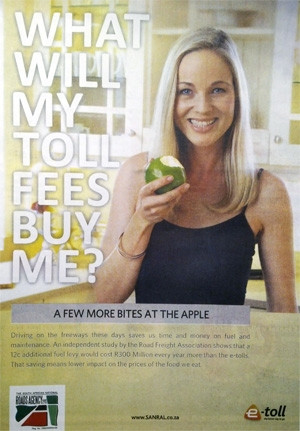
Gautengers can expect to start being charged at the 49 gantry points strewn across the province's highways in roughly a month's time.
This is according to the Department of Transport (DOT) and comes a week after president Jacob Zuma signed the Bll that was the last hurdle for the department and the SA National Roads Agency (Sanral) to cross before e-tolling could commence.
Transport minister Dipuo Peters said yesterday that now that the Transport and Related Matters Amendment Bill (e-toll Bill) has Zuma's mark on it, the DOT needs a mere month to finalise its obligations before going ahead with its long dormant multibillion-rand e-toll project.
And, now that the e-toll Bill is officially part of the law of the land, government's transport ministry is strongly urging motorists who may have been sceptical and reluctant to purchase an e-tag in the past, to register.
No cut corners
DOT spokesperson Tiyani Rikhotso says, based on the amount of work that is left to do, the time frame of about a month is realistic.
"What is left, now that the e-toll Bill is passed and the minister [of transport] has approved the e-toll regulations, is just a matter of dotting the i's and crossing the t's."
The next step, says Rikhotso, is for the regulations that speak to tolling details - like road signs and specifications - to be published for information purposes. Thereafter, the department has to publish draft e-toll tariffs for public comment - a step he says will be taken "within the next week".
A 30-day period will follow, after which the minister will "have to consider the input received and make a final determination". Rikhotso notes, however, that the DOT does not need to wait for the finalisation of the public participation process before it can move on.
After the final tariffs have been gazetted, and added to the e-toll regulations, a notice informing the public of the e-toll commencement date will be published, and e-tolling will officially go live 14 days or more days later.
He says the latest time frame is in line with what the department expected and says e-toll critics should note the only reason the said steps were not taken earlier was because the DOT was waiting on Zuma's signature on the e-toll Bill. "We want to make sure we have carried the whole process out thoroughly. We don't want to cut corners anywhere."
Food for thought
Meanwhile, Sanral's campaign encouraging motorists to get tagged continues, with its latest newspaper advert (pictured) intimating the advent of e-tolling will bring the prices of food down.

The advert reads: "What will my toll fees buy me? A few more bites at the apple. Driving on the freeways these days saves us time and money on fuel and maintenance. An independent study by the Road Freight Association shows that a 12c additional fuel levy would cost R300 million every year more than the e-tolls. That saving means lower impact on the prices of the food we eat."
Howard Dembovsky, chairman of Justice Project SA, refutes the claim. He says while Sanral touts a study saying 12c on the fuel levy would cost the RFA R300 million a year more than e-tolls, it fails to take into account that only 3.56% of all of the vehicles on the road in SA are heavy goods vehicles. "The rest are motor cars and other classes of motor vehicles which consume significantly less fuel, but account for 96.44% of the vehicles on the road.
"Deduct from this the 2.95% minibuses (which we will assume are minibus taxis, but are not all in fact) and the 0.54% buses on our roads, which are exempt from e-tolls - and we are left with 92.95% of the vehicles on the road having a study applied to them which was calculated on a mere 3.56% of the vehicle population."
He refers to Sanral's suggestion as eyewash, asking: "Do any of us really believe that food prices will not rise with heavy goods vehicles having to pay R3 500 a month each for capped e-toll fees on the Gauteng Freeway Improvement Project only?"
Share